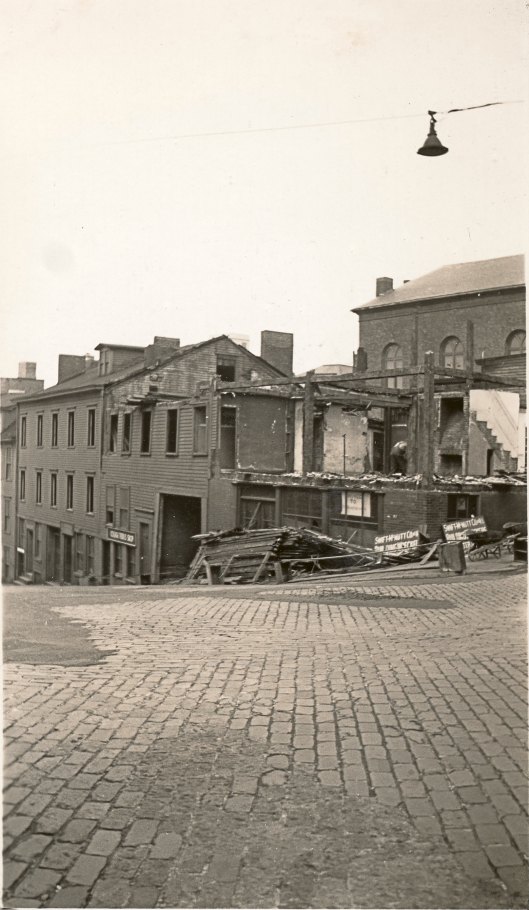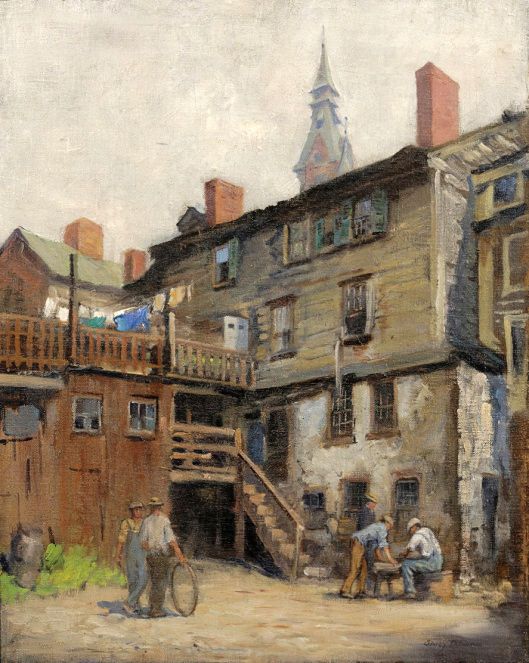This Friday ‘Picture Postal’ follows last week’s, which had the same location but looked toward the city. In 1935 old buildings on lower College Street, Providence R.I, were demolished. Here we see 32-34 College Street in the process of demolition.
The wheels of modernity were spinning up and the motor car was the future. Horse-yards, and the antiquarians and artists who might haunt them, were increasingly surplus to requirements. We can imagine that Lovecraft, who lived further up the street at No. 66, objected to the demolitions. As he had at the demolition of the Old Brick Row, and other regretful changes to the city’s fabric. Though I can find no evidence that he did so for the bottom of College Street. Given the state of some of the backs (24-28 seen above), and the need for grand schemes in the Great Depression, it might have been difficult to publicly call for their preservation. Such is the way of it. Someone in authority makes a quiet decision somewhere and a street or area starts to be neglected. 15 or 20 years later the place is in such a state that it ‘has’ to be demolished, and it’s by then difficult to argue in favour of preservation.
Here we see local artist Stacey Tolman’s drawing of one of the yard entrances in the former ‘Rosemary Lane’, or one very much like it, and another from the other side showing the last days of usage for horses.
Here we see the back courtyard of No. 32 (top) and No. 33 (bottom), with the motor car replacing the horse in the yard at No. 33.
Tolman had earlier painted this yard at No. 33 in happier days, with its calm bright scene poised between industriousness and a faint threat.
Today, cynical modern eyes might instantly see men gambling and idle slum-boys playing hoop, or might raise a lip at the ‘chocolate-box’ sheen common to the Rhode Island art of the period. But the men are looking over plans for a worthy new horse-carriage for the somewhat Lovecraft-like man standing by them. Sturdy working apprentices stand ready to fit an iron rim to a hand-crafted wheel. An industrious wife has hung out lines of washing and one can just see her fresh green herb-pots on the same platform. This is a picture of a living place at work, but threatened by time. A point Tolman has emphasised by having the fateful clock tower of the Courthouse peering over the rooftops, steadily striking out the hours.
Did Lovecraft know the courtyard? He comments on the matter in a letter of April 1925. His aunts had both sent him a sketch of the courtyard, presumably printed in the local paper. He was astounded that he had never actually seen this inner court… “in all the thousands of times I have passed up & down College Hill.” However, being thus aware of it, we can be fairly sure that he visited it at least once on his return to Providence.
The demolitions appear to have inspired Lovecraft’s ever-fertile imagination. Late in his life, in a bitter winter, he ventured out from No. 66 to visit with a local girl admirer. Her memoir later recalled…
“Did we know, he asked, his sombre eyes intent on our faces, that recently, when early buildings on Benefit Street and College Street were razed to make way for new ones, deep tunnel-like pits, seemingly bottomless and of undetermined usefulness, were discovered in the ancient cellars?” — memoir of a visit by Lovecraft in 1934, by Dorothy C. Walter.
It was, of course, a test to see how imaginative she really was. As Lovecraft wrote a few years later…
The bulk of the human race lives very little in the imaginative realm; hence can seldom grasp the goals, motives, & aspirations of anyone with whom subtle perspectives, symbolic associations, & obscure mental correlations form important emotional factors.
The end result of the demolitions, looking up the lower part of College Hill…









Pingback: Another sketch of the College Street courtyard | TENTACLII : H.P. Lovecraft blog
Pingback: ‘Picture Postals’ from Lovecraft: the Courthouse | Tentaclii